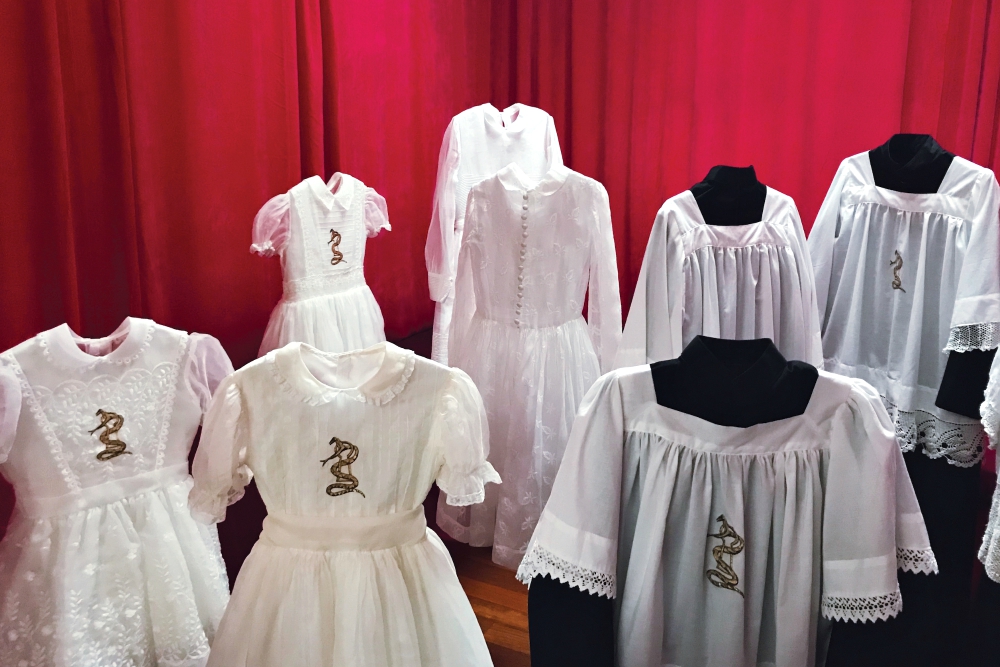
Trina McKillen, "The Children," detail (Courtesy of the artist and Lisa Sette Gallery with Laband Art Gallery)
Tucked around a quiet corner of a small courtyard at the intersection of three buildings at Loyola Marymount University, a large banner with the image of an altar boy's black-and-white surplice hangs at the front entrance to the modest Laband Art Gallery and welcomes visitors with a single word: "CONFESS."
"Confess" is a work of installation art by Irish artist Trina McKillen. In what I like to describe as three "chapels," McKillen's designs draw the visitor to contemplate Catholic liturgy, piety, iconography, children and arguably the greatest scandal to ever hit the Catholic Church: the sexual abuse of children and its cover-up.
The timeliness of this exhibition is remarkable: the upcoming Feb. 21-24 meeting at the Vatican between heads of bishops' conferences from around the world and the pope to confront the scandal, and Pope Francis' acknowledgment of the new face of clerical sex abuse that is unfolding in real time, the abuse of nuns.
McKillen was born in a Catholic segregated ghetto of Belfast, Northern Ireland, in 1964, the eighth of nine children. When she was 5, "The Troubles" began and she recalls dodging bullets on her way to school.
"It was a very frightening experience to live in a place where there was always violence," she told me in an interview. "When the sirens went off for a bomb scare during school they would line us up and lead us into St. Teresa's Church. I always felt safe in the church."
At the age of 10, McKillen and her family moved to Dublin for safety. The father, Paddy, worked with future Nobel Peace Prize winner John Hume on the peace process and this made their family a target.
"I was always drawing, and I remember one day when the IRA knocked on the door and said they wanted to take my father's vehicle for a job they were doing. They just walked in and through the living room to my parents' room," she said. "Art and fear are related in my life. I began to approach art as a way to alleviate my fear."
In Dublin, McKillen and her sisters went to a private convent school, where her interest in art grew and developed. She then went on to study sculpture at the National College of Art and Design in Dublin with a side interest in theater and set design. After graduating in 1989, she returned to Southern California, where she had spent a summer during college studying and working.
That summer, she said, was "a totally expansive time for me. I got a job making in-store displays; I was doing installation art! And they paid me money!"
'The heart and soul of the church'
In McKillen's current exhibition, there are two factors that played into her decision to create it. The first was a cancer scare.
"When it didn't spread, I began asking myself, what is my purpose here? What am I supposed to do? I wanted to show my son that I was brave," she said. "One of the things that upset me was the clergy sex abuse issue."
Against this backdrop of the awareness of her own mortality came her parents' 60th anniversary in 2008.
McKillen and her siblings gathered with their parents to celebrate, and for some reason she asked her mother, Peggy, if she still went to Mass.
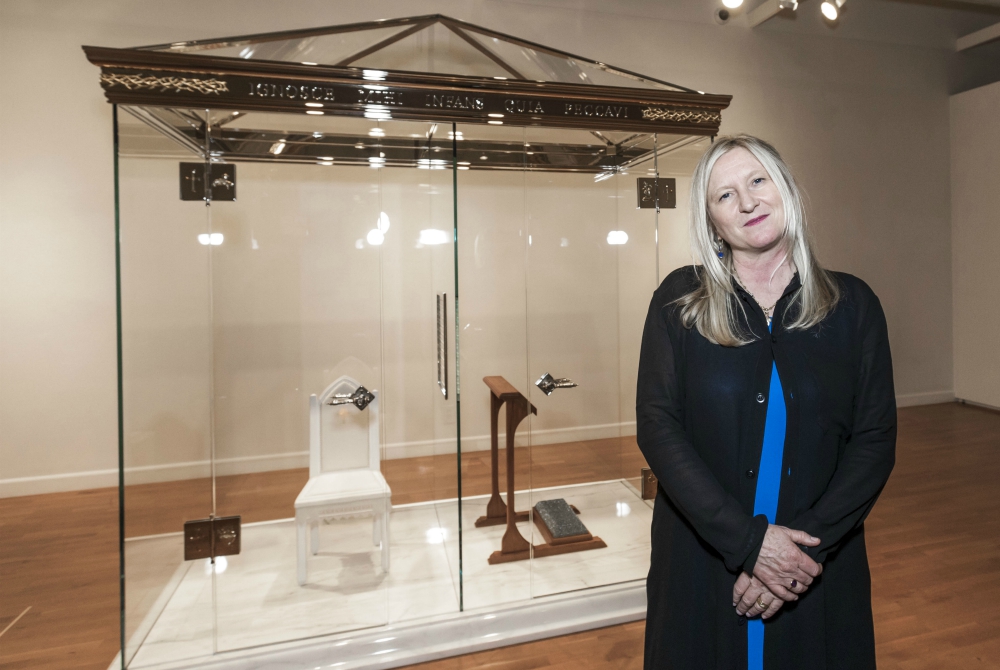
Trina McKillen at the Jan. 19 opening of "Confess" at the Laband Art Gallery at Loyola Marymount University in Los Angeles (Monica Orozco)
" 'No, not very often. Not really,' she whispered to me. 'I can't go and look the priest in the face with what's been happening with the children.' That she had privately decided not to go to Mass anymore was heartbreaking to me," McKillen said.
"She had nine children and 15 grandchildren. Priests had been in our house a lot when we were growing up, we were sent off to summer day camps; we had nothing but reverence for priests. So, the idea that my mother at the age of 84 would hear this horrific news and decide not to go to Mass broke my heart. She is the heart and soul of the church. The church should be on its knees thanking her for teaching the faith to her children. She'd been abandoned."
With this, McKillen decided to do something. On the plane ride home from the anniversary celebration, she sketched what would become the elegant glass confessional piece "Bless Me Child for I Have Sinned."
In a case at the rear of the gallery, that original sketch is on display with a photo of her and her mother and other artifacts relevant to the show.
"If there is an argument for religion, my parents are it," she said. "They brought us up to love and care for other people and to fight injustice, to be decent people."
Confession, healing, haunting
It is easy to imagine the Laband Gallery like a big church with three separate chapels. One is "Bless Me Child for I Have Sinned," or, as I call it, the chapel of transparent confession. The second is "Stations of Hope," or chapel of healing and light, and the third, "The Children" or the chapel of haunting.
" 'With Bless Me Child for I Have Sinned,' I wanted to make something to reverse the roles of priest and child," McKillen said. "It is a glass-enclosed confessional, transparent. The confessional was very scary and full of shame for me as a child. I would make up sins! I didn't understand sin or absolution as a child. A dark room with a man on the other side was very frightening. I wanted to show what needs to happen now: The priest needs to kneel down and confess to the child. The chair is covered in white linen and edged with crocheted lace for purity. I wanted to give the idea of hope even in the fact of this horrific sin."
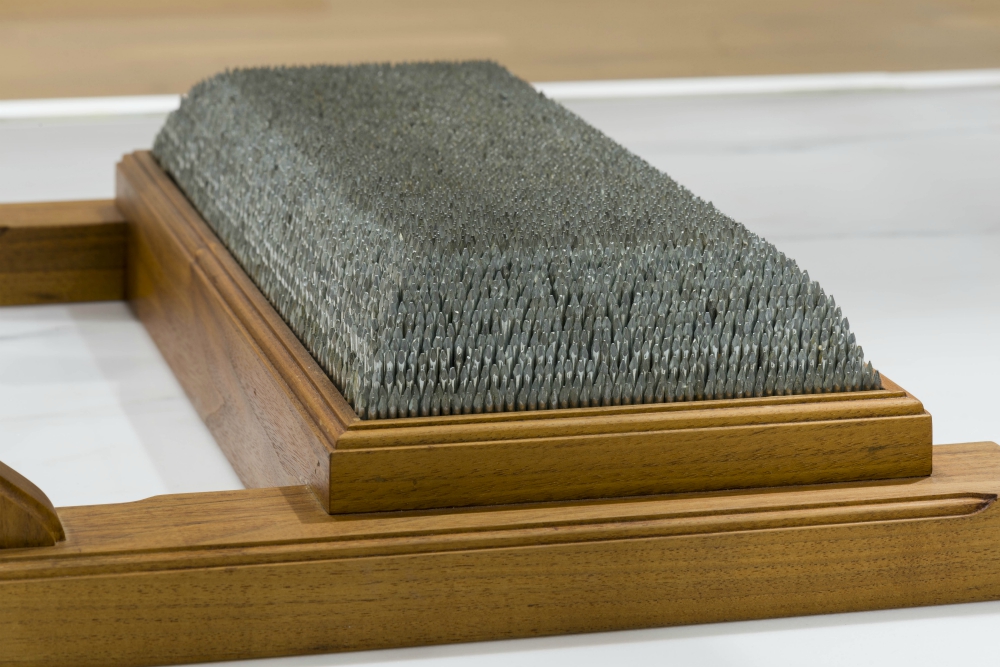
Trina McKillen, "Bless Me Child for I Have Sinned," detail (Courtesy of the artist and Laband Art Gallery/Ruben Diaz)
She started to build the confessional in 2010.
"It's a very architectural piece of work, a very masculine piece. The wood, gold, glass, metal, every single detail is thought out completely," she said. "I had to work with a lot of men to make this possible. This was very intimidating for me because I didn't want to tell anyone what I was doing.
"When I started it, I was really scared, afraid that I would get into trouble, that someone might interpret what I was doing was against the church. But I wanted to speak the truth. I was conflicted and constantly reassuring myself that it would be OK."
The kneeler is made up of 3,600 nails that create an image of a cushion. The screen is transparent Plexiglas perforated with crosses, "as if the sins were going through and absolved by the child," she said.
"I wanted to make this as beautiful and disarming as possible," she said.
There are two hinges on each door that McKillen carved first in clay then cast in bronze. On the priest's side, one shows a keyhole with a snake entwined in it, juxtaposed next to a cross, to show the evil of the misuse of the priest's power to forgive. On the child's side, there is an image of a lamb and on another the Sacred Heart.
"The Sacred Heart is there to honor my mother," McKillen said. "She would always say when I was feeling down, 'Go into your room, put on your favorite music and pray to the Sacred Heart.' The Sacred Heart of Jesus was her best friend."
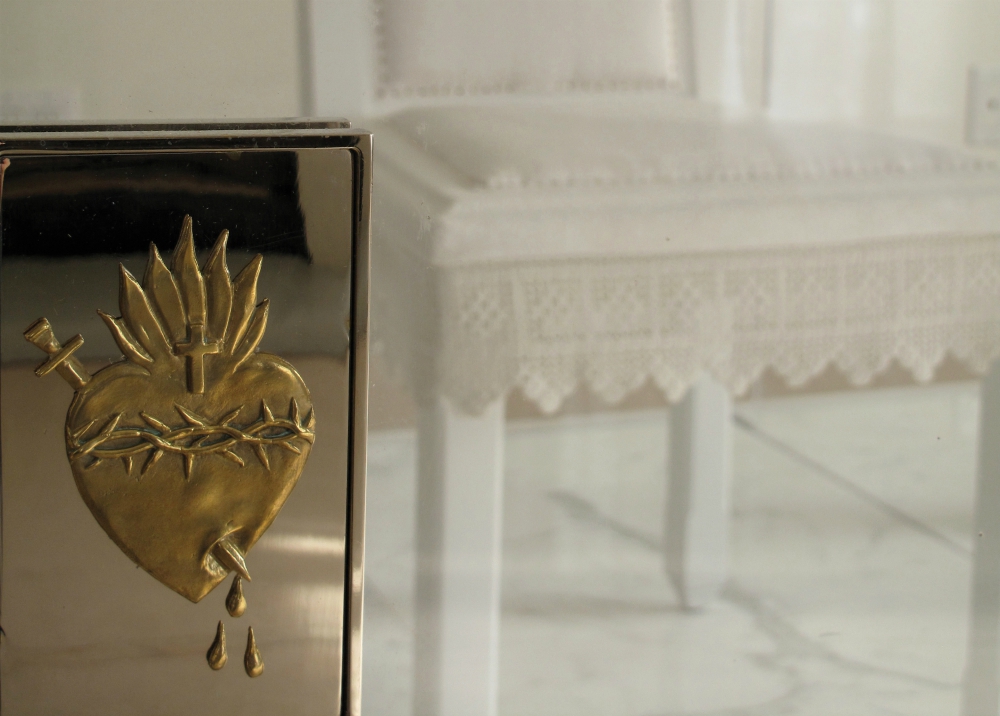
Trina McKillen, "Bless Me Child for I Have Sinned," detail (Courtesy of the artist and Laband Art Gallery)
The crown of thorns surrounding the top of the confessional was molded in clay then covered with a nickel plate. McKillen made the thorns in 2011 using a 3D printer, a brand-new technology at the time.
"This entire project was very much a work of research and development as I went along," she said.
McKillen began "Stations of Hope" in 2008 and finished it in 2013. The background of the chapel is navy blue with window boxes, framed in walnut, 3.5 inches deep.
"The first station is one white cushion," McKillen said. "I started to make these little rectangles to give myself something to do after I got the good news that my cancer had not spread, to start a new way to live without fear"
She continued, "I didn't know what I was doing, but I wanted to make these little squares out of Irish Belfast linen that came from my home, that belonged to me, to the people I grew up with.
"Then I realized they looked like poultices like my father used to make, bandages that would draw out the pain, infection, the hurt. I think I was making these for myself, forming some kind of cathartic therapy. I felt happy making them."
Advertisement
The seventh station is somewhat different from the others because for the first time a word is embroidered onto the little pillow: the word "Good."
"I will let you into a secret," McKillen said. "There are lots of words behind all of these pillows or poultices. But I decided to make only two visible: Good and Sin. The words were embroidered on the poultices and were a way to help me begin but then I became scared of the words."
I asked McKillen if the eighth station's red square represented blood.
"I never thought of that; that is what occurs to you. To me, it is the way it looks aesthetically, framed in a priest's gold vestment fabric, nailed down around the edge of the inside of the box," she said.
At the 12th station, one of the poultices has 12 tiny little lambs on it. McKillen explained that she found the lamb piece in a toy store in Spain years ago.
"Here the idea is that the Catholic Church is our shepherd, and lambs are young, playful and happy," she said. "I loved it because it looks so playful, each sheep is doing something different."
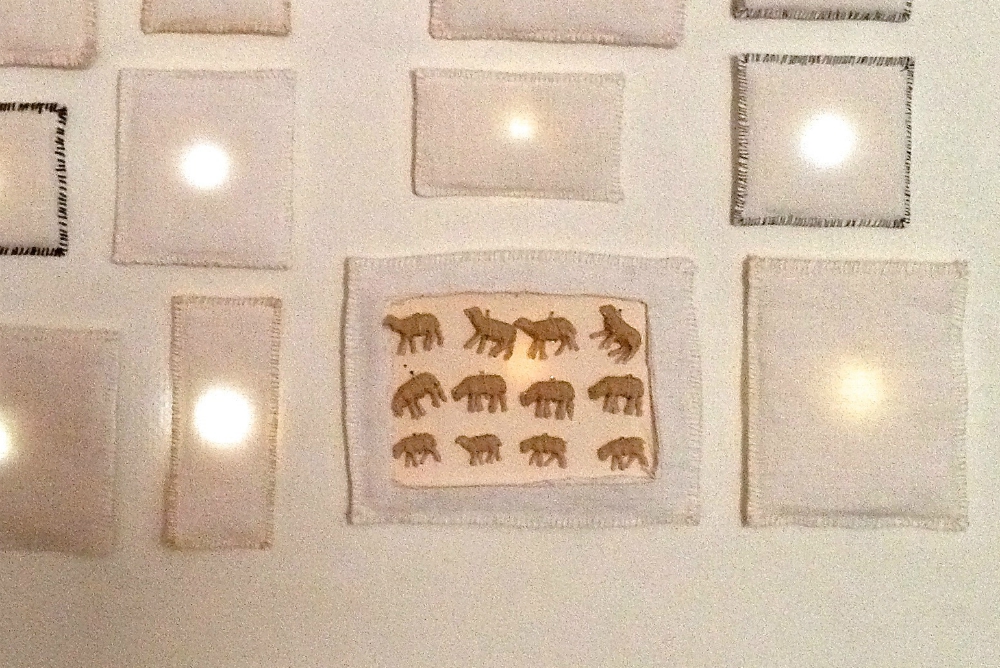
Trina McKillen, "Stations of Hope 12," detail (Courtesy of the artist and Lisa Sette Gallery with Laband Art Gallery)
"I was always disturbed by the stations of the cross, the idea that my sins made Jesus suffer," she added. "I really thought about the nails going through Jesus' hands, what he felt and what his mother felt.
"In what became these stations of hope, there are nails in the edges but a flickering light in the middle of each one. I wanted to create something alive and hopeful. Like at night when you drive by people's homes and you see light shining in their windows, and it gave me comfort."
"There is light and hope — this is what I wanted to achieve," she said. "Now it's up to all of us."
The last chapel, "The Children," is made up of 20 used altar boy vestments and 20 Communion dresses that McKillen sourced over years.
"When Pope Francis visited [the U.S.] in 2015, I believed he would deal with the sexual abuse crisis because he is such a lovely human being," she said. "Then when he spoke, he addressed the bishops and said he was sorry for what had happened to them — not the victims. It was so wrong; the children were not being seen."
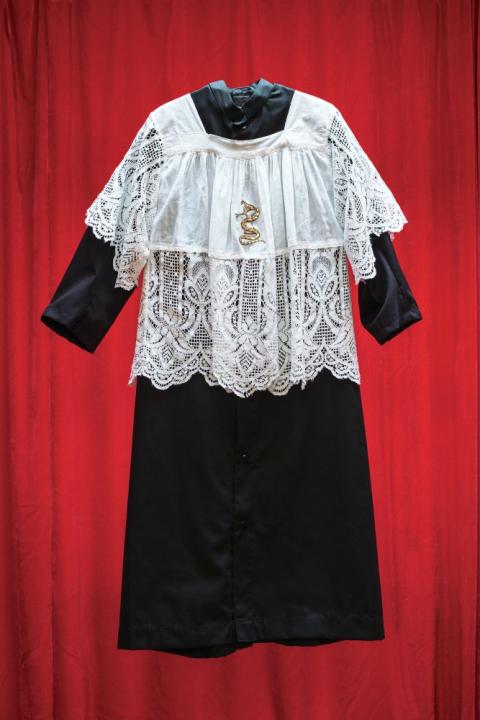
Trina McKillen, "The Children," detail (Courtesy of the artist and Lisa Sette Gallery with Laband Art Gallery)
"I had just been to a SNAP [Survivors Network of those Abused by Priests] conference. I felt I needed to go and meet the survivors because this exhibition is not only about me. Seeing all the survivors hit me like a tsunami."
"I wanted to create a sea of these garments to represent the children who had been abused," she added. "It was obvious to me that the pope and clergy were not seeing these victims as children. You see adults who were victims and you don't see the injured child. Everything happened in secret, behind closed doors. The children were not believed and even if the parents did believe them, the church did not believe them."
The background of the installation is red velvet, which McKillen said shows the "opulence of the church, a church that should have protected the children."
The faceless garments hang by filament threads from the ceiling, some turning slowly in a ghostly way.
"The contrast is haunting but not dark," she said. "When I started to put these garments together, I felt like I was looking after the children. As I opened each package with the children's clothing, I would experience a wave of sadness. Then I would tenderly wash and iron the vestments and care for them."
Making it better
"Confess" came to be exhibited at Loyola Marymount University, a Jesuit school in Los Angeles, explained Karen Rapp, director of the gallery and curator of the exhibition, through the Irish Studies Program and the encouragement of Finbar Hill, honorary consul general emeritus of Ireland, and his wife, Carmel, who had seen the work in McKillen's studio in 2018.
Rapp was invited to see the installation pieces and was impressed.
"My approach to my job is to try to understand my community and to speak to them through exhibitions that are relevant to them," Rapp said. "Seeing the beauty of the work and what Trina wanted to say, it seemed like the Laband Gallery at LMU was a perfect home for it."
It meant meeting with the Jesuit community and getting input from different departments such as the Student Affairs Office, to make sure there would be an intelligent and compassionate way to make the exhibition happen. Although an exhibition like this usually takes two years to produce, Rapp and her team did it in only seven months.
"The uncanny thing," Rapp said, "is how the topic of 'Confess' became an international story after the Pennsylvania [grand jury] report was released in November 2018 and now is the subject of the upcoming meeting at the Vatican."
And, yes, Rapp said she would love to take this exhibition to other venues and universities.
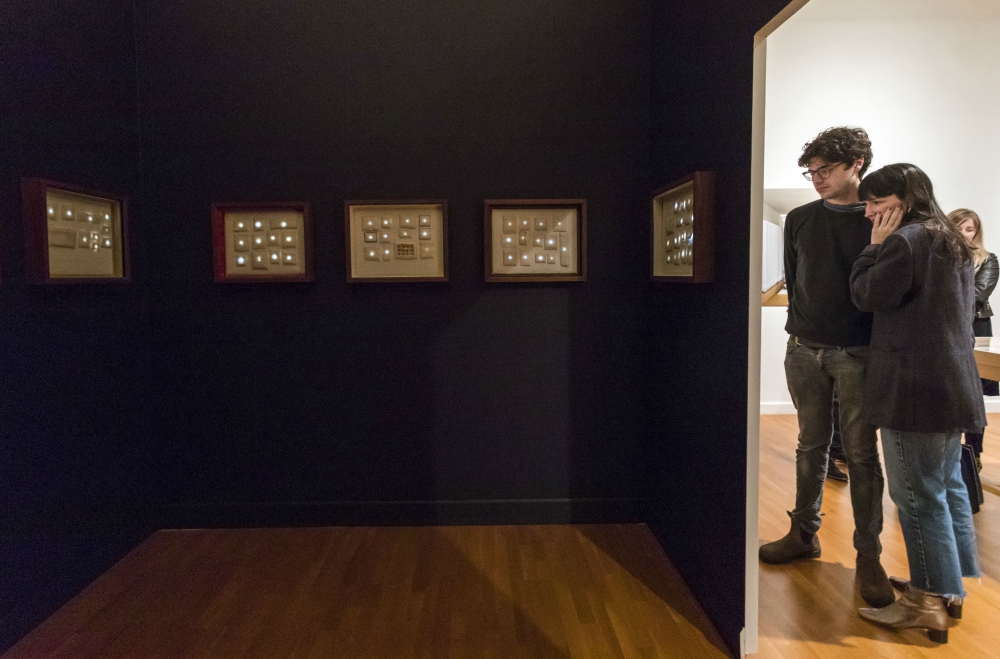
Trina McKillen, "Stations of Hope," installed at the Laband Art Gallery (Courtesy of the artist and Lisa Sette Gallery with Laband Art Gallery/Monica Orozco)
"To me, this show comes from a place of love of the church," said Molly Corey, manager of the gallery. "The artist uses the language of the church and all these ecclesial details and touches, but flips them to make us see something different. There is no anger; instead the art allows people to listen to the work. It is very profound without any ugliness; this helps the storytelling and helps heal.
"Trina McKillen told me that she met a survivor from SNAP and together with his wife and two grown children, he went to see the confessional in her studio. After, they were all hugging and crying. One son said, 'Now we understand what our father went through, it helped us get in touch with our father's feelings.' For Trina, this response to her art helped her get over her fear of creating it."
On the back wall of the gallery, there is a picture of a plexiglass prototype of the confessional. The model is covered with articles from newspaper and magazine articles about the clergy sex abuse scandal.
"Whenever I would find another article, I would cut it out and tape it on the prototype to reassure myself that I was doing the right thing," McKillen said. "It's not wrong. It's still happening."
In the bottom left corner is a cover of Newsweek magazine from April 12, 2010, that bears the image of the Madonna and says, "What would Mary do?" I asked McKillen what she thought the answer to this question is.
"I think she would open the door to the glass confessional, invite the priests in and say, 'Kneel down and say sorry and then complete the penance that the children decide to give you because there is no forgiveness without penance and absolution,' " McKillen said.
But what kind of a penance would children give to an abusive priest?
"It's something we would have to ask them; I am not in a position to give a penance. This is a holocaust. It's a crime against humanity and I think those who commit crimes against humanity have a responsibility if they want absolution," McKillen said. "They need say they are sorry, to own it and they need to actually make sure that people can see what has happened. They need to make a transparent museum with all the files of all the dioceses and parishes.
"Restitution is a huge part of it, a moral restitution. I met a victim from Los Angeles. She said that taking money from an ATM that came from the church did nothing to take away the pain. It's not about money. Money helps, obviously, for therapy and life's needs. It's about real change and renewal.
"I like to call it 'making it better,' because people are afraid of the word change; even the church is afraid of the word change. But if we think of it as making it better, transforming it into something better, then change will happen."
A tiny first Communion dress is framed along the back wall. It's that of McKillen's little sister Michaela, a dress that her mother hand-made — as she did for all her seven daughters. Michaela sent the dress to her son, who attends Loyola Marymount, who gave it to McKillen two days before the exhibition opened, a beautiful surprise that she and Rapp decided needed to be in the exhibition.
"The embroidery is exquisite, there are daisies around the neck and satin ribbon around the cuffs so the lace wouldn't scratch her delicate wrists," McKillen said. "It was like a gift sent from our mother from long ago."
[Sr. Rose Pacatte, a member of the Daughters of St. Paul, is founding director of the Pauline Center for Media Studies in Los Angeles.]








